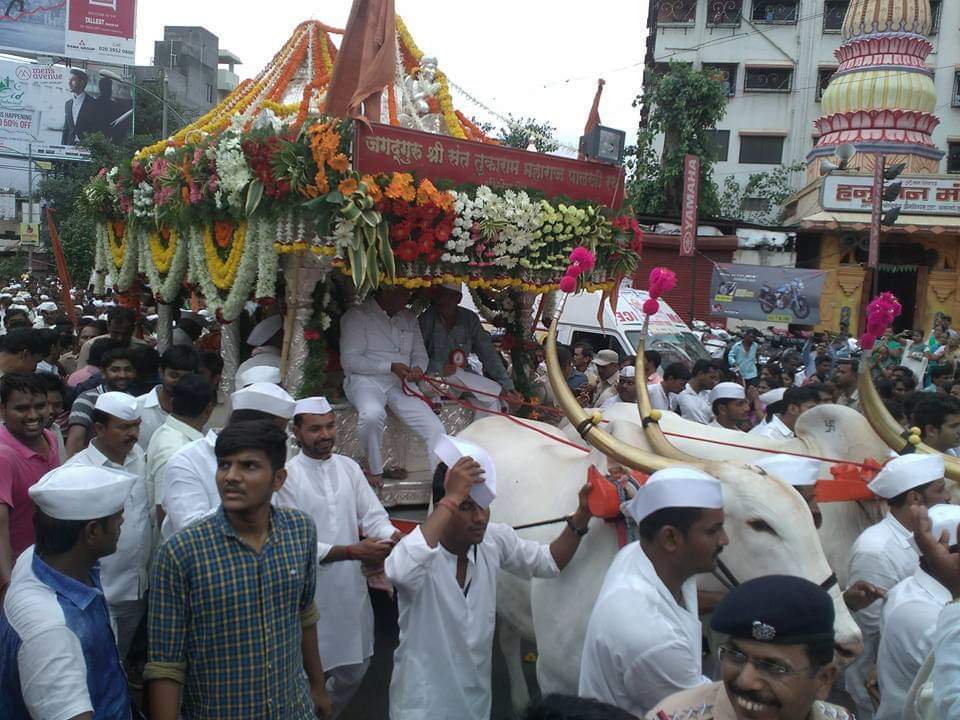Know all about Dnyaneshwar, Tukaram Palkhi route 2019, diversions in Pune

The Pune City police and Changebhai.in have created a webpage which will give information to citizens about the route of Palkhi and also about diversions and other details. Both Palkhi will be in Pune on June 26 and 27, 2019.
Click on this link to know the route :
https://changebhai.in/palkhi2019/
Route of Tukaram Palkhi
The pilgrims known as “warkaris” starts the main pilgrimage from Dehu in Pune district on foot, carrying the palkhi (palanquin) of Saint Tukaram, a renowned devotee of Lord Vitthala, a form of lord Vishnu. It is known as Sant Tukaram’s Palkhi procession. It starts from Dehu & reaches Pandharpur via Akurdi, Loni Kalbhor, Yavat, Varvand, Baramati, Indapur, Akluj & Wakhri respectively.
Route of Dnyaneshwar palkhi
Dnyaneshwar’s palkhi (palanquin), holding the footwear of the saint, is carried with honour in a silver bullock cart from Alandi to Pandharpur.
The pilgrims starts from Alandi in Pune district on foot, carrying the palkhi (palanquin) of Sant Dnyaneshwar’s Palkhi and reaches Pandharpur via Pune, Saswad, Jejuri, Lonand, Taradgaon, Phaltan, Natepute, Malshiras, Velapur, Shegaon & Wakhri to Pandharpur.
Both the palkhis meet at Pune, then at Wakhari and then further meet just before Pandharpur.
What is Pandharpur Wari ?
Pandharpur Wari or Wari (Vari) is an annual pilgrimage (yatra) to Pandharpur – the seat of the Hindu god Vithoba in the Indian state of Maharashtra, in honour of the deity. Palakhis (palanquin processions) carrying the paduka (foot prints) of various saints – most notably Dnyaneshwar and Tukaram – from the Varkari (Warkari, “one who performs the Wari”) sect (which venerates Vithoba), are taken from their respective shrines to Pandharpur. The tradition is more than 700 to 800 years old.
Dnyaneshwar’s palakhi leaves from Alandi, while Tukaram’s begins at Dehu; both in Pune district of Maharashtra. This march on foot from various locations in Maharashtra to Vithoba temple, Pandharpur, attracts a total of over a million pilgrims. The journey takes 21 days. Numerous palakhis join the main Tukaram and Dnyaneshwar palkhis that starts from Dehu and Alandi respectively.
The Wari begins on the 8th/9th lunar day of the waning moon in the Hindu month of Jyeshtha and reaches a day before Ashadhi Ekadashi at Pandharpur. People from various castes and socio-economic backgrounds participate in the Wari, with the common goal to reach Pandharpur.
Devotees from Maharashtra and nearby areas set out for Pandharpur, wearing holy basil beads and singing the glories of Vithoba and songs like “Gyanba Tukaram”, commemorating the saints.
Along with the Dindi (palakhi) procession, service (seva) to the poor and needy, like Amrut Kalash (annadana – donation of food), Narayan seva, medical help and building and repairing of rural infrastructure, is done. This is known as Seva dindi.
From last two years “Niramal Wari” has also started to keep all villages clean during the possession of Wari.
Upon reaching Pandharpur on Ashadi Ekadashi, these devotees take a holy dip in the sacred Chandrabhaga River/Bhima River before proceeding to visit the Vitthal temple.
This is said to be the World’s largest and oldest people movement where people gather on a specific day every year and perform a walk of a distance of around 250 km. Pandharpur Ashadi Ekadashi Wari journey has been honoured by World Book of Records, London under the title ‘One of the Most visited places in a day’.






